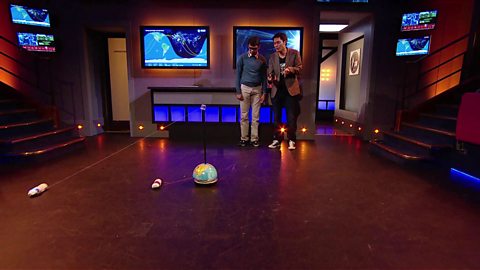Dr Kevin Fong uses an audience member from the Royal Institution Christmas Lectures to demonstrate the effect on the human body of going into space without a space suit.
He uses a marshmallow to model the boy’s head, a glass of water to model his stomach contents and a balloon to model his lungs.
These items are placed inside a bell jar, which is then evacuated using a pump.
The marshmallow expands, the balloon bursts and the water boils at its existing temperature of 37 degrees Celsius.
Kevin explains that boiling is not solely caused by increasing temperature.
This clip is from the Royal Institution Christmas Lectures 2015.
Teacher Notes
You can use this clip to challenge students’ understanding of the process of boiling and how it is affected by pressure.
Curriculum Notes
This clip will be relevant for teaching KS3 and GCSE Physics.
This topic appears in OCR, Edexcel, AQA, WJEC KS4/GCSE in England and Wales, CCEA GCSE in Northern Ireland and SQA National 4/5 in Scotland.
More from the Royal Institution Christmas Lectures 2015
What is Newton's Cannon and Third Law? video
Dr Kevin Fong demonstrates projectile motion, orbit and Newton’s Third Law.

Using Earth’s rotation to launch a rocket. video
Dr Kevin Fong demonstrates how a space rocket’s launch direction affects its success in reaching orbit.

Resonant Frequency. video
Dr Kevin Fong explains how sound vibrations could pose a real threat astronauts and rockets in space.

Orbital Rendezvous. video
Dr Kevin Fong demonstrates how and why it's so hard for a spacecraft to catch up with the International Space Station.

What does gas weigh? video
A demonstration that carbon dioxide can be poured because it is denser than air.

Why are bones weaker in orbit? video
Kevin Fong explains how micro-gravity can weaken bones. Models are used to show that bones are strong but light, and how low gravity weakens them.

How micro-gravity disorientates us. video
A demonstration of how dizziness occurs during motion sickness or micro-gravity.

The danger of orbital debris. video
Dr Kevin Fong and NASA astronaut Dan Tani explain the danger of space debris.

Demonstrating heat shield material. video
Dr Kevin Fong explains that space capsules heat up due to pressure not friction. He demonstrates a heat shield’s low thermal conductivity.

Why Earth rock is found on the Moon. video
Dr Kevin Fong demonstrates how debris from meteorites hitting Earth threw Earth rock as far as the Moon, leaving clues there about Earth’s geological history.

Demonstrating radiation detectors. video
Dr Kevin Fong shows how a Geiger-Muller tube can detect ionising radiation but not the type of radiation, and how detectors on the International Space Station can.

How Earth protects us from radiation. video
Dr Kevin Fong discusses the dangers to astronauts of solar radiation, and how we’re protected from it by Earth’s atmosphere and magnetic field.

Why tardigrades can survive in orbit. video
Dr Kevin Fong explains why tardigrades are so resilient when exposed to ionising radiation lethal to most other organisms.

How to recycle urine in space. video
Dr Kevin Fong demonstrates a urine recycling system that works using osmosis, concluding by drinking the liquid that is produced.

Ã˝